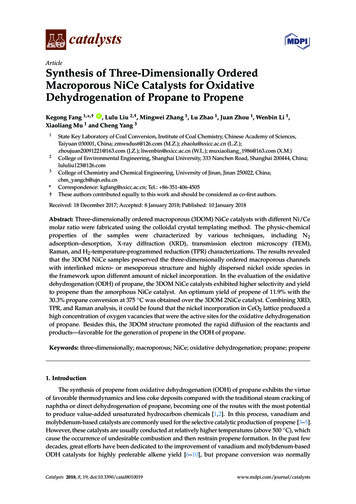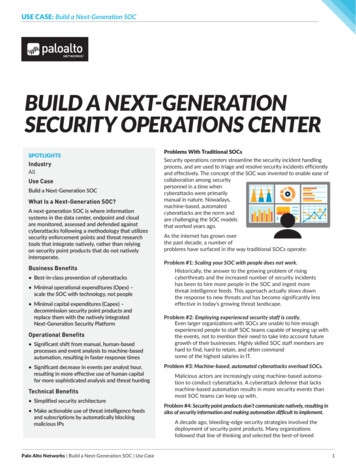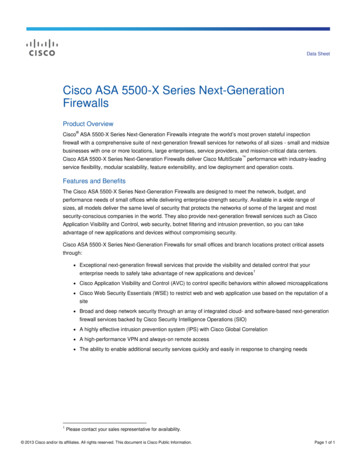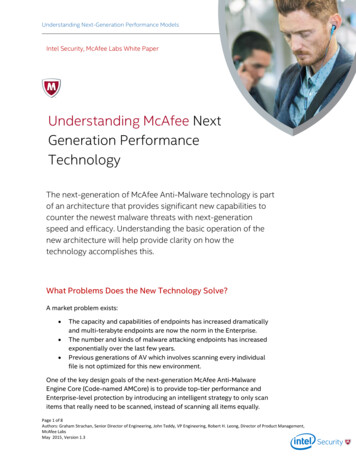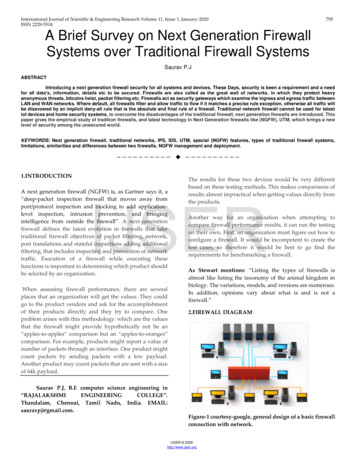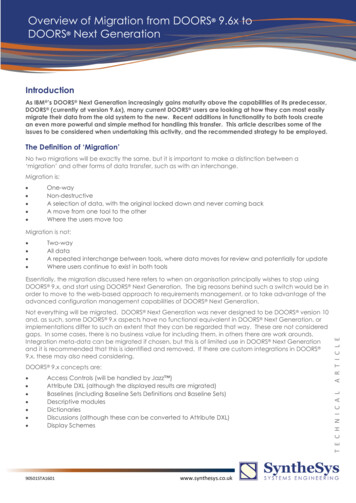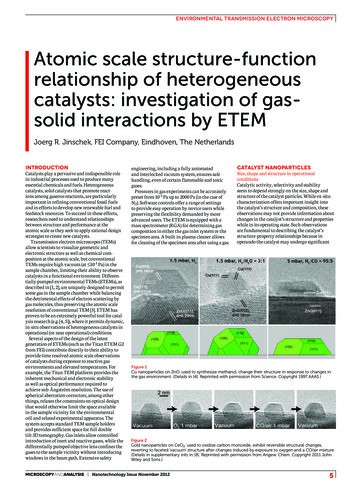
Transcription
2016 DOE Vehicle TechnologiesProgram ReviewNext Generation Three-WayCatalysts for Future, HighlyEfficient Gasoline EnginesChristine LambertFord Research and Advanced Engineering9-June-2016Project ID: PM067
OverviewTimeline Start Date: 1-Oct-2014 End Date: 30-Sept-2017 Status: 50% completeBudgetBarriers Long lead times formaterialscommercialization Cost Total funding: 1,690,470– DOE share: 752,376– Contractor share: 338,094– Additional ORNL 600,000 Funding in FY 2015– 301,228 ( ORNL 600,000) Funding in FY 2016– 257,494Partners Ford Motor Company Oak Ridge National Lab University of MichiganProject ID: PM0672
Relevance Overall Objective Develop new three-way catalysts and/or catalyst systems capable ofachieving durable 90% activity [HC, CO, NOx] at 150 C.Today’s automotive three-waycatalysts (TWCs) become highlyefficient only when exhausttemperatures reach 250-400 C.‒The next generation of engines will bemore efficient and thus producecooler exhaust at low load conditions‒TWC activity will be required at lowertemperatures to satisfy strict emissionstandards with the next generation ofautomobiles. Current Budget Year ObjectivesObjective: Lower T90% Conversion‒Light-off Curves over afresh production TWCtested by ACEC protocolExhaust Temperature ( C) Identify/characterize new materials, and predict performance and costs. Identify/capitalize on synergies between various catalyst materials withinand between partnersProject ID: PM0673
MilestonesMilestoneStatusConfirm Reactor ComparabilityCompletedNov. 2015Commercial vs. New Material Performance – Status (BP1)CompletedNov. 2015Down-select Promising Materials/Confirm Synthesis and Characterization Path(s)CompletedOct. 2015Confirm Test Protocols and Down-select CriteriaCompletedOct. 2015Confirm Benchmark State of the Art TWCCompletedOct. 2015 Cross lab comparisons and test protocol were confirmed Tested and compared commercial TWC material to new materials developed in-house Agreed to keep all material synthesis pathways active through this budget period Agreed on test protocol and laboratory systems to allow cross-lab comparisons. Agreed no new benchmarking was necessary.Commercial vs. New Material Performance – Status (BP2) Evaluations of new materials made in house and comparison to the commercial TWC material willcontinue throughout project as new materials show promise.System Model Assessment – Status New assessments will be completed as necessary.OngoingMar. / Jun 2016Cost Model Assessment – StatusSept. 2016Down-Select Promising CatalystsSept. 2016 New assessments will be completed as necessary. Determine which catalysts and/or catalyst materials should be carried over into Budget Period 3.Project ID: PM0674
Approach/Strategy Identify strategies to improve preciousmetal dispersion and promote activityMake and characterize new materials,and predict performance and costsLeverage cross-laboratory analyticalcapabilitiesOxide overlayer on oxide supportImproved dispersion and enhanced lowtemperature activity on using nanophaseparticles of ceria-zirconiaProject ID: PM0675
PartnershipsFord Motor Company Modified Support Materials Use novel, high surface area, layered oxides as precious metal supports Estimate finished catalyst costs; predict vehicle tailpipe performance. Cost and Performance ModelsOak Ridge National Laboratory Modified Support Materials Investigate modification of supports for thermal stability, adherence of metalto the support, and tailoring the metal-support interactions for optimalcatalytic performance. Ternary Oxide Development as PGM Substitute Investigate the functionality of low-PGM or PGM-free, ternary-oxide catalystsystems, starting with CuO-CoO-CeO (CCC).University of Michigan Core-Shell Model Catalysts (incl. monolith cores) Investigate catalyst architectures containing a core-shell conformationcomposed of a metal nanoparticle surrounded by a metal oxide shell. Synthesis will begin with silica, alumina, and ceria-zirconia-based modelcatalyst systemsProject ID: PM0676
Accomplishments[H2O] 10%[CO] 5000ppm[H2] 1700ppm[O2] {stoichiometric}[C3H8] 150ppmN2 or Ar Balance250150100500ORNLFordU. Of Michigan200ORNLFordU. Of MichiganACEC stoich protocol:300ORNLFordU. Of Michigan Good agreement at eachresearch lab even thoughsample weights rangefrom 0.1 to 2.0 g350ORNLFordU. Of Michigan Evaluated at all partnerorganizations using protocoldeveloped by ACEC tech team400ORNLFordU. Of Michigan TWC aged by Ford– 50h 4-mode durability– 960 C max bedtemperature450T50 (solid) and T90 (open) in C“Round Robin” confirmedreactor similarities withaged modern TWCCONOxNOxC2H4C2H4C3H6C3H6C3H8C3H8[CO2] 5%[C3H6] 500ppm0.2 – 3.4 slm flow[NO] 1000ppm[C2H4] 525ppm0.1 – 2.0 g crushed monolithProject ID: PM0677
AccomplishmentsPerformance of Catalysts in the Fresh StateBestFreshPerformanceTarget Fresh production TWC does not satisfy the T90 target of 150 C for any exhaust gasSome of the overlayers with 2% Pd outperformed the production TWCThe Rh on ZrO2 overlayer had the best fresh performance Fresh CO T90 near program targetProject ID: PM0678
AccomplishmentsPerformance After 950 C Oven Aging in Air/H2OTarget 1.7% PdProdTWCAll of the over-layer formulations had better performance than the production TWCafter lean aging at 950 CThe 2% Pd on TiO2 overlayer provided the best performance‒Performance improves after lean aging!Project ID: PM0679
AccomplishmentsTarget 1.7% PdProdTWCProject ID: PM06710
AccomplishmentsGoal: Improve ZrO2 surface area throughdeposition on SiO2 core Previous lean data suggested Pd/ZrO2 waspromisingCoat a SiO2 with ZrO2 shell then add 1% PdPd particles are on ZrO2 shell, but initial depositionhas poor dispersion improvements underwayElemental mapswhile rotating afresh sample 40 (TEM).Aged10 h 900 Cat stoichZrSiPdThis research was performed, in part, using instrumentation provided by the Department of Energy,Office of Nuclear Energy, Fuel Cycle R&D Program, and the Nuclear Science User FacilitiesProject ID: PM06711
AccomplishmentsEnhanced activity through deposition ofwell defined nanoparticles of Ce-Zr withtargeted deposition of Pd Dispersion of Ce-Zr nanoparticles on Al2O3 Target deposition of Pd on nanoparticles onCe-Zr– TEM used to confirm both nanoparticles andtargeted depositionCOT90 242 CNOxT90 258 CCOT90 267 CNOxT90 296 CCOT90 310 CNOxTHCT90 304 C2% Pd onCeZr/Al2O3THCT90 312 CT90 229 CPdTHC (prod TWC)1% Pd onCeZr/Al2O3T90 201 CCeTHCT90 268 C4% Pd onCeZr/Al2O3Project ID: PM06712
AccomplishmentsTernary Oxide as PGMsubstitute shows promise,but only for CO CuO-Co3O4-CeO2 (CCC) catalyst hasshown inhibition resistance for leanCO oxidationAlso a good CO oxidation catalystunder stoichiometric conditionsCCC is clearly poor for HC and NOand can only be considered as a“specialist” for COContinuing work CCC catalyst as a CO oxidation“specialist”; use less PGM in system New Formulations: Increase surface area, Cucontent, and Cu-Ce interfaceactive site Improve the already good COoxidation activityProject ID: PM06713
88 µmol/gcatalyst111 µmol/gcatalystProject ID: PM06714
AccomplishmentsOne-Pot Synthesis of Pd@SiO2 Core@Shell Catalyst1) Core@shell by flame spray pyrolysis2) Simple 1-pot synthesis of core@shell3) Now being extended to other shelloxides (e.g., Pd@TiO2, Pd@SiO2-CeO2)# of particles200Size of Pd cores150100500# of particles80TEM1234Core size (nm)5STEM6SiO2 shell thickness6040200567891011Shell Thickness (nm)1213Project ID: PM06715
AccomplishmentsActivity Comparison by CO Oxidation Probe ReactionFeed: 1% CO, 1.5% O2, balance N2, 400ml/min flow, 60 mg sample Fresh (thin lines) and aged (thick lines) at 850 C for 4 h in dry airCore@ShellPd@SiO2Conversion Pd/SiO2ConventionalSupportedTemperature ( C) New synthesis route leads to thermally stable Pd@SiO2 core shell catalystPd@SiO2 is better dispersed after aging at 850 CPd@SiO2 shows improved light-off behavior after aging at 850 CProject ID: PM06716
AccomplishmentsTest Results for Hydrothermally Aged Pd@SiO2 Core@Shell CatalystsFeed: Full mix, 212 ml/min total, 5% water; 60 mg fresh Pd@SiO2 (solid line); 60 mgaged Pd@SiO2 (dotted line); aging in air at 800 C for 10 h with 6% water Simple one-pot synthesis for Pd@SiO2 core-shell catalyst has been developed Core-shell catalyst shows better activity than supported Pd/SiO2 catalyst Pd@Al2O3 and Pd@CZO will be more hydrothermally durableProject ID: PM06717
Remaining Challenges andBarriers Longlead times for materials commercialization Use materials with known, high stability in automotive exhaust Use commercially available support materials as a base andadd new materials onto base to support metals in novel ways Combine novel materials into a complete catalyst Partner with major automotive catalyst supplier in third year Cost Develop stable, high surface areas for better metal dispersion Balance PGM within system to take advantage of lower costswhen possible Investigate base metals as PGM substitute Fewer processing steps are desirableProject ID: PM06718
Proposed Future Work Identify and capitalize on synergies between various catalystmaterialsDemonstrate full aging (hydrothermal-chemical) and performancefrom coated monolith cores using most promising materialsIdentify system solutions and estimate vehicle performance andcostLayered designsCCC / HC trapRh/CZOcore shell Pd/modified aluminasubstrate wallCatalyst zoningCCC/ HCtrapRh/CZO &core shellPd/modifiedaluminaProject ID: PM06719
Response to Previous Year’sComments Thisproject has not been previously reviewedProject ID: PM06720
Summary Relevance: TWC materials required to be active at lower temperatures tosatisfy strict emission standards with the next generation of automobilesApproach: Make and characterize new materials, and predictperformance and costs; leverage cross-laboratory analytical capabilities Collaboration: Full collaboration between Ford, UM, and ORNL Technical Accomplishments Commercial TWC “round robin” was used to demonstrate reactor-to-reactorcompatibility amongst all three partners Overlayers of metal oxides on high surface area alumina successfully resulted in equalor better TW performance in aged state, most notably Pd/TiO2/Al2O3 and Rh/ZrO2/Al2O3 Pd on zirconia shell and ceria-zirconia nanoparticles showed some promise; more workneeded Ternary base metal oxides “CO specialist”; also stores NOx at low temperatures Successful demonstration of one-step core@shell synthesis;pursuing additional shell materials with improved stability during aging Future work: continue towards shorter lead times for materialscommercialization and lower costsProject ID:PM06721
Technical Backup
Technical BackupACEC Test ProtocolsFour Mode Aging CycleRepeated on pulsating flamecombustor for 50 hProject ID: PM06723
Technical BackupProject ID: PM06724
Technical BackupProject ID: PM06725
Technical BackupProject ID: PM06726
Technical BackupProject ID: PM06727
All of the over-layer formulations had better performance than the production TWC after lean aging at 950 C The 2% Pd on TiO. 2. overlayer provided the best performance ‒ Performance . improves. after lean aging! Performance After 950 C Oven Aging in Air/H. 2. O. 1.7% Pd. Prod. TWC. Target . Project ID: PM067 9
